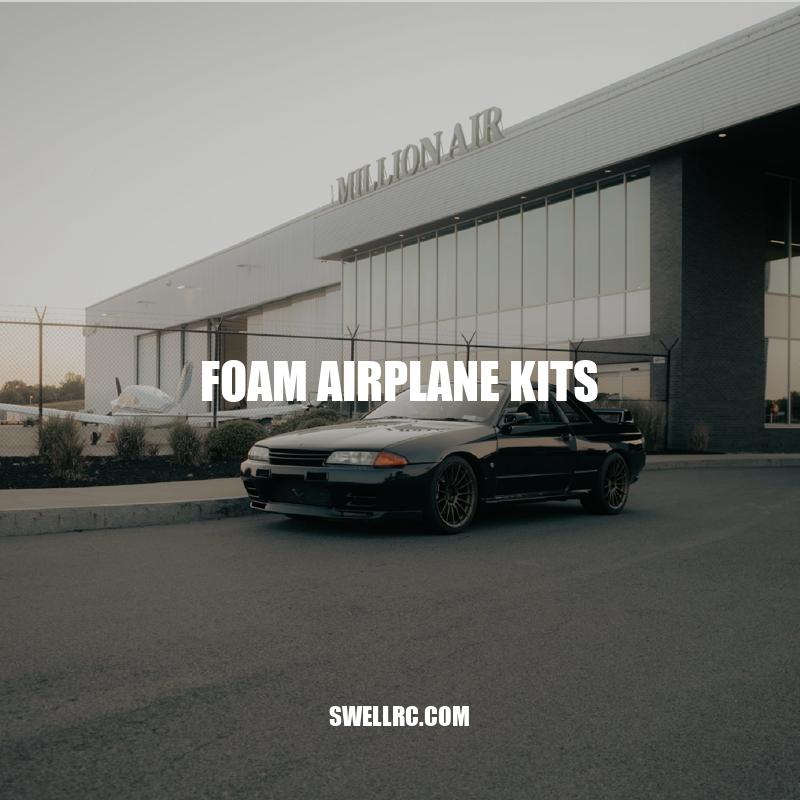Foam Airplane Kits: A Beginner’s Guide
Foam airplane kits have become increasingly popular among aviation enthusiasts of all ages and expertise levels. These kits provide aspiring aviators with the perfect opportunity to enjoy the thrill of flying without the steep learning curve or high expenses associated with other models like the traditional balsa wood airplanes. Foam airplane kits are designed for easy assembly, making it the best choice for beginners who would like to develop their skills with model building and flight. Also, foam airplane kits are incredibly versatile, with various offerings that range across different types of planes, from gliders, trainers, and acrobatic planes to scale replicas of real-life planes. These foam airplanes are also customizable, meaning that users can create a unique look and feel to their planes. The best part is that the materials used to make foam airplane kits cut both the costs and weight of the finished product, allowing the planes to fly even faster and farther. Finally, foam kits are also incredibly easier to repair, reducing maintenance expenses, and making it less stressful for beginners who inevitably experience crashes and accidents while learning to master their planes.
Types of Foam Airplane Kits
Foam airplane kits come in different types depending on the skill level and preferences of the user. These include:
- Gliders: Designed for beginners, gliders are straightforward to build and fly. They do not require power to fly, making them a perfect option for those who would like to get a feel of flying.
- Trainers: These are designed for those who are new to foam airplane kits but have some proficiency with RC gliders. Trainers are typically made to be stable and easy to control, making them an ideal choice for learners of all ages.
- Acrobatic Planes: These airplanes are aimed at intermediate pilots who are looking to try some complex moves and tricks. Acrobatic planes typically have high power output, agile control surfaces, and are quick to respond to commands.
- Replica Planes: For those who want to fly planes that resemble real-life planes, replica foam airplane kits are an excellent option. Such planes range from military jets to commercial airliners and are ideal for hobbyists interested in dioramas or collectors seeking unique pieces.
With the rise of e-commerce, buying the right foam airplane kit has never been easier. There are several online stores that sell different types of foam airplane kits from various manufacturers, making it convenient to find a kit that meets the user’s needs. Examples of these stores include Amazon, HobbyKing, and Horizon Hobby. Some manufacturers also sell their foam airplane kits directly from their websites, allowing users to purchase kits that come with unique and exclusive features.
What are the different types of foam for RC planes?
Table for reference:
| Foam Type | Features | Recommended For |
|---|---|---|
| Expanded Polypropylene (EPP) | Durable, flexible and absorbs impacts well | Beginner pilots, training planes, 3D planes |
| Expanded Polystyrene (EPS) | Lightweight, rigid and easy to shape | Gliders, indoor planes, electric planes |
| Depron | Thin, lightweight and easy to cut | Micro planes, park flyers, indoor planes |
- EPP foam is perfect for beginner pilots as it is the most durable, flexible and absorbs impacts well.
- EPS foam is best for creating lightweight planes with rigidity for better gliding.
- Depron foam is great for micro planes, park flyers and indoor planes due to its thinness and lightweight properties.
If you’re looking for materials to build your RC plane, various options are available at websites like HobbyKing, Flite Test and RCGroups.
Benefits of Using Foam Airplane Kits
There are several benefits to using foam airplane kits, including:
- Affordability: Compared to traditional balsa wood models, foam airplane kits are much more affordable, making them accessible to hobbyists and enthusiasts with a limited budget.
- Customization: Foam airplanes kits are extremely versatile and come in various types and sizes. They also offer customization options allowing users to modify the planes to their liking, adding personal touches, and making them more unique.
- Durability: Foam airplanes are more durable than balsa wood models, which are susceptible to cracking and breaking in the event of a crash or mishap. Foam airplanes are lightweight and flexible, enabling them to absorb impact poorly and prevent total destruction.
According to a study conducted by the Federal Aviation Administration (FAA), foam airplane kits are responsible for fewer accidents and injuries compared to balsa wood models. Due to their light design and slower speeds, foam airplanes tend to be safer to operate in public parks and backyards. Additionally, with the introduction of advanced computer technology, traditional remote control systems have been replaced with more user-friendly, simple, and intuitive options, broadening the appeal of aviation hobbies and making them more accessible than ever before.
Check out Horizon Hobby’s foam airplane kit selection to find your next project!
Are foam RC planes durable?
Yes, foam RC planes can be durable depending on the quality of the foam used and how well they are constructed. Some foam RC planes are made with high-density foam which makes them more resistant to crashes and damage. It’s important to note that foam planes can be more prone to damage from direct sunlight or extreme heat.
Here are a few tips to help keep your foam RC plane durable:
- Store your plane in a cool, dry place out of direct sunlight when not in use
- Invest in a foam-safe glue for any repairs or construction
- Fly your plane in an area clear of obstacles and avoid flying in high winds
If you’re in the market for a foam RC plane, make sure to do your research and read reviews before making a purchase to ensure you’re getting a quality, durable product.
Tips for Building Foam Airplane Kits
Building foam airplane kits from scratch can be an enjoyable challenge, but it’s essential to follow certain tips to ensure the best results. Here are some valuable tips to build foam airplane kits:
- Read the instructions: Make sure you understand the instructions that come with your foam airplane kit. Pay close attention to the order in which the parts are assembled, and don’t skip any steps.
- Use the right tools: Using the right tools can make the difference between a great build and a mediocre one. Make sure you have the necessary tools, such as a hobby knife, glue, and sandpaper.
- Glue the parts together: Foam airplane kits require a lot of gluing, make sure that you use a suitable adhesive for foam parts such as cyanoacrylate or PVA glue. Always apply glue evenly, and remove any excess before allowing the parts to dry.
- Balance the airplane: ensure that the weight is distributed evenly, especially in the front and back.
- Test fly your plane: After building your plane, it’s important to test fly it to check that it flies as expected and that it is balanced and stable.
Additionally, online communities and websites provide valuable resources, such as forums, articles, and tutorials, giving foam airplane enthusiasts a space to share their knowledge, exchange ideas, and seek advice from experts and peers. Some popular websites include HobbyKing, FliteTest, and the International Plastic Modelers Society.
What kind of foam do you use to make a plane?
Foam used to make a plane is typically made of Expanded Polystyrene (EPS) or Extruded Polystyrene (XPS). EPS is lighter in weight and less expensive, while XPS is stronger and more durable.
Some popular foam products used in plane building include:
- Dow BlueCor Foam
- Depron Foam
- Foamular Insulation Board
- FoamTac Adhesive
Online retailers like Amazon and Flite Test offer a variety of foam materials and accessories for plane building. Before purchasing, check the specifications and reviews to ensure the foam fits your needs.
| Material | Pros | Cons |
|---|---|---|
| EPS Foam | Lightweight, less expensive | Less durable |
| XPS Foam | Stronger, more durable | More expensive |
Conclusion
In conclusion, foam airplane kits offer a fun and exciting way to explore the world of model aviation, with a range of customization options and kits available to choose from. By following basic assembly tips and guidelines, building a foam airplane from a kit is an easy and rewarding task that can promote creativity and improve hand-eye coordination. Additionally, foam airplanes are lightweight and can fly longer and faster than other traditional models.
Once you are done assembling your foam airplane from a kit, testing it under safe conditions in an open field close to the ground is essential. Always ensure that the battery is fully charged, the propeller is secure, and the components are balanced before attempting to take off the plane. The adventure that follows, however, is worth all the effort. Flying the airplane is a thrilling experience that offers hours of fun, learning, and exploration.
Overall, foam airplane kits are an accessible and affordable hobby that ignites creativity and promotes problem-solving and engineering skills for both children and adults. So, don’t hesitate to start your foam airplane kit project today and experience the joy of building and flying something unique and fun.



